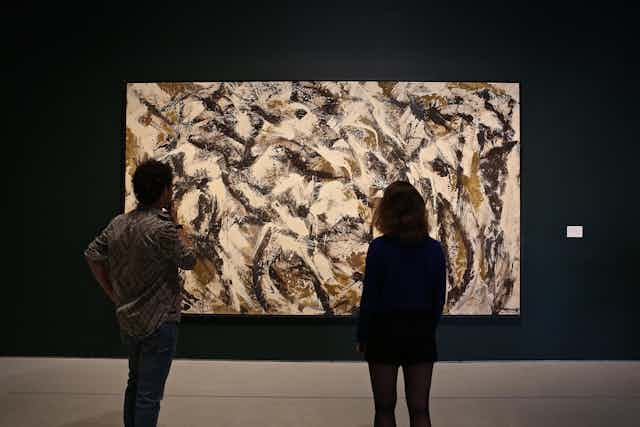The Barbican’s boldly curated exhibiton of abstract expressionist Lee Krasner (1908-1984) – who was routinely referred to as Jackson Pollock’s wife, despite being a well-established artist long before meeting him – transferred to the Guggenheim Bilbao in 2018. Before it opened, a Spanish newspaper invited me to introduce this “little known” artist. I responded: “Welcome to a party that we feminists have been enjoying for 50 years.”

Over the last decade, major museums around the world, from London’s National Gallery to Philiadephia’s Barnes Foundation have presented exhibitions of women artists including Artemisia Gentileschi (1593-1653), Suzanne Valadon (1865-1938), Berthe Morisot (1841-1895), Hilma af Klint (1862-1944), Camille Claudel (1864-1943), Georgia O’Keeffe (1887-1986), Dora Maar (1907-1997), Saloua Raouda Chocair (1916-2017), Louise Bourgeois (1911-2010), Nan Goldin (1953-), and Zanele Muholi (1972-) to name just a few.
Why is this exhibiting spree so belated? Beyond the virulent institutional sexism of the 20th century that exiled women from the annals and museums of art, blockbuster exhibitions are notoriously expensive. Insurance, transportation, publications, curatorial research and publicity cost big money.
Massive sponsorship is needed but hard to attract when there is little public recognition. This recognition has been systematically denied to women by the knowing silence of 20th century art historians and the way museums have omitted women and other minorities from their selections.

But now, in key museums such as the Tate, women have become directors. They and their senior curators have been inspired by decades of feminist research to exhibit an expanded, more inclusive vision of art history. I salute their determination and courage, often having endured – and now defeated – the belittling dismissal of women artists that occurred during the 20th and early 21st centuries.
Why do we need to see women as artists?
Women have produced our histories and cultures just as much as men. They offer the missing half of our sense of human complexity. We need to know women as creative individuals, subjects who make art and not merely objects represented by men.
A well-researched solo exhibition unites works scattered across museums and private collections, revealing both consistencies and changing directions over a career. As these shows increase in number, we get to see our world anew from each woman’s historical and aesthetic take on class, gender, race, sexuality, physicality and imagination.
Nothing replaces a direct encounter with the actual works. My dream of seeing Artemisia Gentileschi’s paintings at the National Gallery was crushed by the 2021 lockdown. I really wanted to experience their scale, their colour and materiality, to trace gestures and details that reveal her painterly thinking.
I longed to compare her two versions of one woman’s daring political assassination, Judith and Holofernes. I wanted to understand her subtle shifts of emphasis when she changed scale and space – only discernible when both were placed side by side. One painting is held in Naples, the other in Florence.
In 2018, I made a day trip to the Musée Jacquemart-Andrée to see the works of the American impressionist Mary Cassatt (1844-1926) in the first large-scale exhibition in Paris since 1893. In the late 19th century Cassatt lived, worked and exhibited in France and had been an active member of the radical new painting community. Now, only six of her works can be found in French public collections – a tiny number compared to her male impressionist colleagues.
I also visited the Musée D’Orsay’s first major exhibition of one of the founders of the impressionist movement, Berthe Morisot. This important show made tangible the increasing energy and freedom of her daring execution while underscoring the psychological subtlety in her representations of the child, the adolescent girl, the pregnant woman and her ageing self.
The personal vs the artistic
But to sell big shows of women artists to sponsors and to attract new audiences who will pay, the pitch is often personal rather than artistic. This involves silencing, by omission, challenging feminist interpretation while promoting public fascination with the artist through sensationalising the details of their lives.
Employing spurious melodrama rather than sensitive analysis, Gentileschi is famed for being raped rather than for being the first woman admitted to the prestigious Accademia dei Arte del Disegno founded in Florence in 1563, or for her many international collectors and commissions, or the way she combined career and parenthood.

Sculptor Camille Claudel is presented as a tragic woman betrayed by her older artist-lover. But the horrifying cruelty of her family who forced her into a mental asylum for menopausal depression where she was locked up for the rest of her life, is sidelined.
A Marxist activist, influential teacher and leading artistic presence in Mexican modernism, Frida Kahlo (1907-54), has been commercialised as an icon of exotic fashion or rendered the pathetic victim of life-long disability, childlessness and a heartless husband.
In 2019, the Guggenheim New York mounted an exhibition of the work of 19th-century Swedish artist and mystic Hilma af Klint. Her beguiling abstract paintings attracted the foundation’s largest ever public attendance – 600,000 visitors despite little immediate name recognition. Her catalogue sold 30,000 copies, beating the record of the 2009 Kandinsky show and was responsible for a 34% spike in Guggenheim memberships.

Like the other big museums, the Guggenheim was reaping the rewards of tenacious feminist research and pioneering curation that challenged the modern exclusion of women as artists. So it is important to acknowledge the profile-raising work of curators such as Catherine de Zegher and Iris Mueller-Westerman who both worked on bringing af Klint to the public.
Feminist art history has created the environment in which these blockbuster shows became possible – however long it has taken. It has also educated and inspired women as curators, who, moving into positions of power, can make more egalitarian decisions about who we see in our art galleries.

